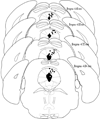Effects of intra-PAG infusion of ovine CRF on defensive behaviors in Swiss-Webster mice
- PMID: 17095103
- PMCID: PMC3253759
- DOI: 10.1016/j.bbr.2006.10.003
Effects of intra-PAG infusion of ovine CRF on defensive behaviors in Swiss-Webster mice
Abstract
The midbrain dorsal periaqueductal gray (DPAG) is part of the brain defensive system involved in active defense reactions to threatening stimuli. Corticotrophin releasing factor (CRF) is a peptidergic neurotransmitter that has been strongly implicated in the control of both behavioral and endocrine responses to threat and stress. We investigated the effect of the nonspecific CRF receptor agonist, ovine CRF (oCRF), injected into the DPAG of mice, in two predator-stress situations, the mouse defense test battery (MDTB), and the rat exposure test (RET). In the MDTB, oCRF weakly modified defensive behaviors in mice confronted by the predator (rat); e.g. it increased avoidance distance when the rat was approached and escape attempts (jump escapes) in forced contact. In the RET, drug infusion enhanced duration in the chamber while reduced tunnel and surface time, and reduced contact with the screen which divides the subject and the predator. oCRF also reduced both frequency and duration of risk assessment (stretch attend posture: SAP) in the tunnel and tended to increase freezing. These findings suggest that patterns of defensiveness in response to low intensity threat (RET) are more sensitive to intra-DPAG oCRF than those triggered by high intensity threats (MDTB). Our data indicate that CRF systems may be functionally involved in unconditioned defenses to a predator, consonant with a role for DPAG CRF systems in the regulation of emotionality.
Figures






References
-
- Baldwin HA, Rassnick S, Rivier J, Koob GF, Britton KT. CRF antagonist reverses the "anxiogenic" response to ethanol withdrawal in the rat. Psychopharmacol (Berl) 1991;103(2):227–232. - PubMed
-
- Bale TL, Vale WW. CRF and CRF receptors: role in stress responsivity and other behaviors. Annu Rev Pharmacol Toxicol. 2004;44:525–557. - PubMed
-
- Bandler R, DePaulis A, Vergnes M. Identification of midbrain neurones mediating defensive behavior in the rat by microinjections of excitatory amino acids. Behav Brain Res. 1985;15:107–119. - PubMed
-
- Bandler R, DePaulis A. Midbrain periaqueductal gray control of defensive behavior in the cat and the rat. In: Bandler R, DePaulis A, editors. The midbrain periaqueductal gray matter. New York: Plenun Press; 1991. pp. 175–197.
Publication types
MeSH terms
Substances
Grants and funding
LinkOut - more resources
Full Text Sources
Miscellaneous

